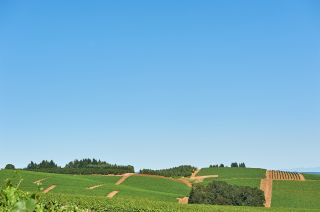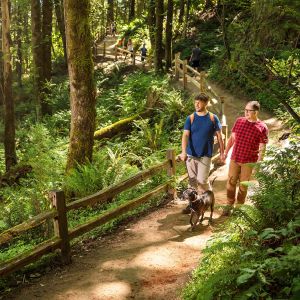Sip and Savor Willamette Wine Country
Explore the diversity of the Oregon wine experience.
The Willamette Valley (pronounced will-AM-met), is the most populated valley in Oregon and is home to all five of the state’s largest cities. It stretches from Portland at its northernmost point, 150 miles (241 km) along the Willamette River just south of Eugene.
Go car-free and indulge in one of many guided wine tours throughout the valley. According to the Willamette Valley Wineries Association, the valley is “one of the premier pinot noir producing areas in the world” because the Coast range to the west and the Cascade range to the east ensure the grapes neither freeze in the coastal winds nor burn in the high-desert sun.

Small-town charm abounds throughout this pastoral landscape. Step into Europe without ever leaving American shores in Mt. Angel, whose culture was established by a Swiss monk and Bavarian immigrants. Explore Oregon’s “Garden City,” Silverton, or walk through the covered-bridge capital of the West in Cottage Grove.
History of the Willamette Valley
There’s a myth that the word Willamette originally meant “the valley of sickness and death,” an odd phrase for this impressively fertile and abundant valley, which tens of thousands of indigenous people used for agriculture, fishing and hunting before colonization.
After their journey from the west on the Oregon Trail, colonizers landed in the valley to file land claims, when Oregon City became the first incorporated city west of the Rocky Mountains. It’s much more likely that Willamette is the colonized pronunciation of “Willamt,” meaning “still water,” and describing a river spot near Oregon City. The Kalapuya, Molalla, and Chinook people settled the Willamette Valley some 10,000 years ago and still call the area home today.
Dining In The Willamette Valley
Oregon Wines in the Willamette Valley
Pinot noir originated in Burgundy, but it thrives in the Willamette Valley due to its climatic similarities; in fact, the difference in taste is marginal. It can be found in rosé, but it’s best known for the acidic, darkly fruity and sometimes even umami reds it can create. There are more than 500 distinct wineries in the Willamette Valley, and while a lot of them grow pinot noir, they also produce pinot gris, pinot noir blanc, chardonnay, riesling and many others.
The state is home to over 20 federally recognized grape growing areas known as American Viticulture Areas, or AVAs. In true Oregonian small-business fashion, more than 70% of our wineries produce fewer than 5,000 cases yearly, so get them before they’re gone!

Credit: Aaron Lee, Travel Portland
Willamette Valley Wines and Where to Get Them
Abbey Creek Wines
More than a winery, Oregon’s first Black-owned vineyard does things their way. Located in the Northern Valley, the Crick, as the owner lovingly calls it, bursts with cozy vibes, communal meals, hip-hop trivia and more. Founder Bertony Faustin states that the most important thing about being Oregon’s first Black winemaker is that he won’t be the last. Learn more about his story with Red, White, and Black, a documentary about Abbey Creek’s journey, available for paid streaming on their website.
Beaux Frères
The pinot here gets name-checked on many a list of Oregon’s best. While this winery on the picturesque Ribbon Ridge in the Chehalem Mountains doesn’t take walk-ins, you can pay ahead for a tasting with their friendly and knowledgeable staff. Or, better yet, attend one of their dreamy food events throughout the year, like summer dinners in the vineyard.
Brooks Wine
Nestled in the Eola-Amity Hills region, Brooks is a favorite with awards committees and wine connoisseurs. It has been on the Wine & Spirits Top 100 Wineries list three times as an exceptional example of the area. Deep leather chairs in the tasting room beckon the weary traveler, while the views from the open-air deck are not only entrancing but dog-friendly. Last but never least, don’t pass on a healthy glass of vino by the fire pit, a favorite for summer nights in the vineyard.




Carlton Winemakers Studio
Come for the charcuterie vending machine, and stay for the Northwest’s first alternating proprietorship and LEED-certified winery. The company employs more than 15 vintners working together at a facility so eco-friendly that the tasting room is designed to use natural sunlight first before deploying any electricity. This is an excellent opportunity to taste some of the smallest wine producers in the state, like 00 and Ridgecrest.
Raptor Ridge
With a focus on inclusivity in the tasting room and cellar, guests at the Raptor Ridge Estate Winery enjoy interesting wines in a comfortable setting. As pictured, the tasting room offers a view that fittingly accompanies the wine in beauty and depth. Open daily, offering wine and small plates along with a robust event schedule that includes yoga, live music and opportunities to learn, this winery has a little something for everyone.

Credit: Andrea Johnson Photography, Travel Portland
Two Towns Cider
Wine’s autumnal sibling, cider, is another bountiful artisanal product of the Willamette Valley. A trip would not be complete without Two Towns, one of the most successful examples of the cider revival. Made by hometown boys Lee Larsen and Aaron Sarnoff-Wood, their extensive offerings range from specialty apple brandies to iconic cosmic crisp ciders and more made only with local ingredients.
Getting Outdoors in the Willamette Valley
The Willamette Valley is also an excellent spot for outdoor sports and recreation — great for folks who aren’t into wine or anyone ready for a break from all the food and drink. Camping, rafting, kayaking, hiking, fishing, snowshoeing and cross-country skiing are all popular activities depending on the weather. With 18 state parks in the valley, there’s no shortage of nature to explore, including well-maintained trails and beautiful flowing rivers, streams and creeks.
Outdoor Excursions in the Region
Enjoy the fresh air and see the sights.
Was this page helpful?








